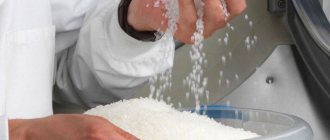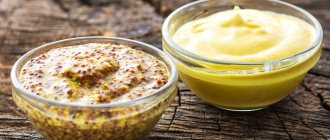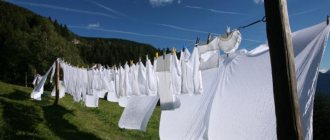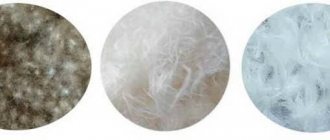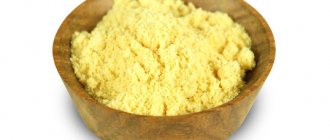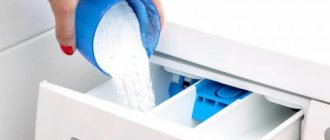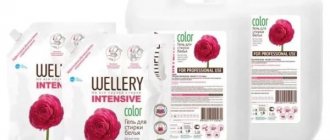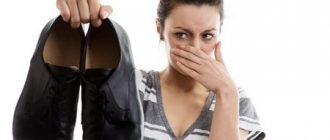Today, washing powder is taken for granted. Without it, a full process of washing things is impossible. However, just 150 years ago people had no idea what it was.
The article will discuss the history of the creation of washing powder, its benefits and harm to human health and the environment, and will list the leading manufacturers of laundry detergents and more.
Description of clothes washing detergent
Washing powder is a synthetic detergent related to household chemicals .
Powders have a complex, multicomponent composition, depending on which the specifics of their application differ.
All modern powdered products undergo granulation, which reduces the degree of dusting and also makes the process of use more convenient.
They are white in color, but in their composition you can often find multi-colored granules (green, red, blue, dark blue). The main purpose of powders is to remove dirt .
History of creation
The first washing powder was created by German chemist Fritz Henkel. Its basis at that time was sodium silicate. In 1876, Fritz organized the Henkel company, which began releasing a new product called “bleaching soda” to the masses. It quickly became popular because it washed things well and was inexpensive.
The first soap powder appeared on the market a year later. Its creators founded the company Thompsons Seifenpulver GmbH. At the same time, the Henkel factory developed.
In June 1907, the first washing powder for cars (Persil) saw the light of day. This saved housewives from having to boil things to make them white.
In Russia, washing powder appeared only in 1953 , it was a product called “Novost”. It was produced in Kazan at a chemical plant. A new round of development occurred in 2000, as a result, a powder with a composition familiar to modern people entered the market.
What's the harm?
The only benefit of powders is their ability to effectively remove various contaminants from things, making them clean. However, they are harmful to the human body and the environment.
For the human body
Surfactants that form the basis of washing powders are highly active compounds. When they enter the body, they accumulate in the cell membranes, covering them with a film and disrupting their functioning. If a lot of surfactants accumulate in the body, they disrupt metabolic processes and can even lead to cell destruction.
Anionic surfactants are especially dangerous . Their harmful effects on the body:
- impaired immunity;
- allergy provocation;
- brain damage;
- increased cholesterol levels in the blood, increased atherosclerosis;
- disruptions in the functioning of the nervous system;
- disturbances in the functioning of the liver, kidneys, and respiratory system.
Anti-active substances have the property of accumulating in internal organs. When they come into contact with unprotected skin, 0.6% of them settle in the liver, and 1.9% in the brain. They have a toxic effect on them.
Phosphates from washing powder only enhance the effect of anionic surfactants, promote their penetration through the skin and increased destruction of membranes. High toxic concentrations of surfactants remain on things for about 4 days.
Environmental impact
Drain water contains synthetic detergents. After processing, they end up in the sewer system and then in natural bodies of water. For the microorganisms living in them, the substances contained in the powders are poisons. They violate the organoleptic properties and biological parameters of water.
Moreover, wastewater containing dissolved powder has a pH level of 7-10, while for normal life of aquatic organisms it is 4.5-5.0. As a result, fish, reptiles and mammals suffer as the food chain is disrupted.
Due to surfactants and other harmful chemicals entering the water, water bodies begin to bloom, turning into swamps.
Variety of shapes and types
The following types of washing powders are distinguished:
Universal compositions for different types of washing.- Machine washing machines.
- For hand wash.
- For delicate washing.
- Contains disinfectants.
- For white and colored laundry.
- For children's clothing.
- With air conditioning.
- For washing in hard or cold water, etc.
Different manufacturers produce different powders. They differ not only in composition, but also in smell. There are three forms of laundry detergents:
- ordinary bulk powders;
- gels represented by liquid concentrates;
- capsules - they contain a highly concentrated liquid gel.
It is most convenient to use capsules, since they do not need to be dosed, they do not generate dust and do not irritate the respiratory tract. However, they cost 2-3 times more than classic washing powder.
Ten best washing powders
- Bimax 100 stains is a universal product that is suitable for most types of material, except silk and wool. Removes heavy stains, including stains from food, coffee and other drinks. It features economical and convenient packaging, but is difficult to dissolve and dilute in cold water;
- Ariel “Mountain Spring” and “Color” give results even in ice water, eliminating stains and unpleasant odors. But they can provoke an allergic reaction and are not suitable for delicate fabrics;
- Frosch Color is a hypoallergenic concentrated product with a mild composition without a strong odor. Contains aloe vera, is used sparingly and eliminates contaminants in cold water without damaging things. But it does not cope with old stains and has a high price;
- Sarma Active is suitable for most types of fabric, white and colored clothing. It is characterized by low cost and economical consumption. It effectively removes difficult stains and kills bacteria, without containing harmful chlorine. However, it does not give results in cold water, is difficult to rinse and has an aggressive composition;
- Tide “White Clouds” is great for washing white clothes and removes stubborn stains from cosmetics, food and drinks, including stains from chocolate and red wine. It is economically consumed, but has a strong specific odor;
- Ecover is an ultra-concentrated modern powder without phosphates, dyes, fragrances and optical brighteners. The environmentally friendly product does not cause irritation or other negative consequences, and easily washes things even in ice water. Suitable for allergy sufferers and children, not harmful to the environment, as it is completely destroyed;
- Losk 9 Total system is a universal product suitable for almost every type of fabric, except wool and silk. Gives a good washing result, but has a strong odor and can cause allergies;
- Nordland ECO is another environmentally friendly product without phosphates, dyes, flavors and other harmful elements. Effectively removes contaminants, is completely washed out and odorless, decomposes by 90%. It is used for both hand and machine washing and is highly expensive;
- Persil Expert Color is an effective stain remover for colored fabrics with softening ingredients. Dissolves in water in a few seconds, acts already at the first stage of washing and protects the color;
- Top House Super Effect is a universal concentrated product for washing white and colored items. Works well on stains. It is distinguished by economical consumption and high price.
Features of choosing a washing composition
When choosing a washing powder, you need to consider its purpose. A prerequisite is to study the composition. You should not buy household chemicals that have expired.
Other points to pay attention to:
- Amount of surfactants. According to existing standards, their percentage should be less than 5%.
- All foreign-made media must have Russian-language information.
- The composition should not contain phosphates; responsible manufacturers replace them with safer zeolites.
- Purpose of the detergent. If the label says “for white clothes,” then it is not recommended to wash colored items with them.
- The composition of baby powder should be as natural as possible.
- The packaging must be tightly sealed, without any signs of tampering.
Read about how to choose washing powder here, for children's clothes - here. The rating of hypoallergenic laundry detergents is presented in this article, odorless powders in this article, and eco-powders in this one.
The difference between powder for hand washing and automatic washing is discussed here, the features of choosing soap powder are here, safe for a septic tank - in this article, the rating of detergents according to customer reviews is presented here.
Amount of powder for quality washing
Manufacturers indicate on the packaging the required (maximum) amount of powder that should be used for one wash. As a rule, they overestimate the required measure, since they are interested in selling their products.
Experts recommend using only 1 tbsp per 1 kg of dry dirty laundry. spoon of powder. This is enough for high-quality washing. If the washing machine is designed for 5 kg of laundry, it is usually loaded only halfway, then 3 tbsp. Spoons of detergent will be enough.
The required amount of powder is an important point that you need to pay special attention to. If there is not enough of it, then things will not be washed well. If you pour a lot of it, then there will be abundant foaming, which will not allow soapy substances to be effectively washed out of things. Or the powder will not be easily washed out of the tray where it is poured, and this is a waste of money.
Top producing countries
Powder production is carried out in many countries, but the leaders in this industry are the following countries:
Japan. Japanese washing powders do not contain phosphates, as they have been banned in the country for several years. They are sold in convenient modern packaging and equipped with a measuring spoon. The most popular brands: Attack, Lion, Miyoshi, Daiichi FUNS, Mitsuei Super Wash.- China. Chemicals produced in China are economical in consumption, have a minimal amount of flavorings, are highly effective and have a hypoallergenic composition. Popular brands: Liby, Keon, BioAqua, Laundry Detergent Sheets, Touching Nature.
- Korea. The formula of Korean washing powders does not contain phosphates, and the main active component is enzymes (enzymes) that are safe for human health and the environment. The most popular TMs: KeraSys Spark Drum, OATS, Lion Beat, Hanjang.
- Russia. Most formulations do not contain phosphates and are also affordable. The most popular brands: Ushasty Nyan, Umka, Sarma, Vorsinka, Stork, Sorti, Lotus.
- Belarus. Washing powders from Belarus wash well, do not contain phosphates and undergo strict control when entering the Russian market. Popular brands: Mara, April, Chaika, SanDay.
You can learn about German washing powders from this article.
Top highest quality powders, according to Roskachestvo
You can determine the quality of a detergent by testing it in practice, but determining how safe it is is not entirely easy to determine at home. Roskoshestvo conducted a study of washing powders for quality and safety, and based on the results, they compiled a rating of the best products.
Burti Color
The powder of this brand should be used for washing colored items. The German manufacturer took care of the quality and safety of the product. According to research, the powder very well removes protein stains (blood), as well as pigment-oil stains (grease).
After prolonged use of the product, things do not lose their original appearance. The fabric remains just as durable and does not pill.
Stork color
This synthetic product is recognized by Roskachestvo experts as a high-quality product, and the safety rating is five stars out of five.
The consumer properties of the product were also highly appreciated. The powder helps soften water, does not foam when washing and rinses well.
Reflect color
Roskachestvo highly praised the safety of the product and its consumer properties. The powder does not cause irritation when it comes into contact with the skin or in contact with the mucous membranes of the eyes, and does not harm the washing machine, since the composition contains water softeners, which means that the machine parts will not suffer from scale or corrosion.
The disadvantages of the detergent were also noted - the formation of a large amount of foam, but at the same time it is easy to rinse.
Ecover Zero
This product is suitable for washing colored items only. It is completely safe for health. The powder copes well with various types of contaminants, including protein, although this is not indicated in the labeling.
The only drawback that experts noted is that with daily use of this powder, the fabric becomes hard.
Frost Color
Phosphates and the mass fraction of sodium silicates in the composition fully comply with the norm, which means that it can be used by people with asthmatic diseases or allergies. The product softens water well and can be easily rinsed out of fabrics, and also prevents the appearance of pilling.
Sarma Active
The powder from a Russian manufacturer is suitable for all types of washing and copes with many stains. After using the product, the fabric does not turn yellow and remains durable. The product does not have a negative effect on the body, therefore it is absolutely safe.
After washing, some mineral substances may remain on things, which do not meet the standards of Roskoshestvo.
Biomio
Washing powder for colored laundry is produced in Denmark. Safety and consumer properties not related to cleaning ability were rated by experts as five out of five. Cleaning ability scored four out of five possible points.
The product meets all Roskachestvo standards and is absolutely safe for the body. The powder removes grease stains well and copes with protein stains. The detergency rating of four is due to the fact that after prolonged use of washing powder, laundry may turn yellow and become rougher.
Compound
The basis of all washing powders are anionic and nonionic surfactants. These surfactants weaken the bonds between contaminants and fabric fibers and prevent them from re-settling.
In addition to surfactants, the composition of laundry detergents is represented by the following components:
- Optical brighteners that create the illusion of snow-white laundry. This effect is achieved due to the deposition of luminescent particles on the fabric. When sunlight hits them, things appear white.
- Oxygen bleach.
- Soda and soap. They are designed to improve the quality of washing.
- Fragrances and flavors responsible for eliminating unpleasant odors and adding freshness to washed laundry.
- Phosphates. These components are necessary to soften water, which improves the quality of washing. Phosphates make laundry soft and protect washing machine elements from scale.
- Zeolites. They act as a safer alternative to phosphates.
- Sodium silicate, which alkalizes surfactants and also binds powder dust into granules.
- Enzymes (enzymes). They break down different types of contaminants through the manifestation of their biological activity.
- Defoamers. These substances prevent excessive foam formation.
Other components:
ballast substances,- solvents,
- chlorine,
- hydrotropes,
- anti-corrosion compounds,
- preservatives,
- antioxidants,
- additives that soften the skin of the hands,
- air conditioner, etc.
Read more about the composition of washing powder here, and about the GOST requirements here.
Features of use
Recommendations for using washing powders:
- compliance with dosage and temperature conditions;
- use of powders according to their intended purpose (for white and colored laundry, for children, for people with hypersensitive skin);
- when washing in an automatic machine, the powder is poured into the first compartment only if the pre-wash or soaking program has been selected; in other cases, the detergent is poured into the second section;
- taking into account the concentration of chemicals - if the powder is concentrated, the dosage is reduced.
Woolen, half-woolen and cotton fabrics absorb surfactants the most, so they need to be rinsed especially carefully.
The rating of washing powders for colored items is presented in this article, for black - in this article, for white - here, for hand washing - here.
Is it possible to pour powder directly into the drum? This article will tell you where to put it correctly, in which compartment - this one, how much to pour - this one.
How to choose washing powder based on composition
Which washing powder is best for washing clothes? One that contains few excipients and fillers. That is why, when choosing the best powder for washing machines or hand washing, you should definitely pay attention to its composition. In addition, it is important to be able to correctly assess the quality of water, because if it is hard, laundry detergents with a minimum content of phosphates will not be able to thoroughly wash clothes, even if you choose the best powders for this.
Typically these products contain:
- Active elements on which the level and quality of foam formation directly depends. According to experts, it is best if the composition contains from 3 to 5% of such components. However, if you use them frequently, it is recommended to rinse your clothes after washing so as not to cause the development of allergies.
- Antisorbents that prevent clean linen from quickly getting dirty after washing.
- Chemical-based bleaches that improve the condition and color of white items. If your laundry detergent contains chlorine, it is better to use more natural ingredients.
- Phosphates and sulfates, due to which the effect of the powder is enhanced and the water is softened. But it’s still not worth washing things with such a powder every day.
- Fragrances that imbue things with a pleasant aroma. It is important to note that the best powder will contain minimal amounts of fragrances, since they can cause allergies if the water quality is poor or rinsing is unsatisfactory.
- Enzymes that exert their active action only on certain types of tissue, as well as at low water temperatures.
- Chlorides that can prevent scale on the parts of the washing machine, as well as avoid the development of corrosion, which often appears as a result of the action of spare parts of equipment with a large flow of water of different temperatures.
Currently, washing machine powder is produced not only in bulk form. Also, a high-quality composition is produced in the form of tablets and gels, which are highly concentrated.
In other words, these forms of powder can quickly remove any dirt at water temperatures up to 70 degrees. It is especially good to use gels or tablets for washing colored items.
It is important to note that if things are very dirty, you should pour the powder not into a special hole on the washing machine, but directly into the drum. And when choosing a composition for hand washing, you should remember that it must be endowed with good foaming properties. In addition, if you are going to wash things by hand, it is recommended to soak them for half an hour in advance - then the washing will be quick and high-quality for the clothes.
In order for the best laundry detergents to do their job well, experts advise mixing several products rather than choosing one universal one. This way, you will not only be able to wash your laundry carefully, but also not damage the washing machine and maintain the shape and color of your items.
The packaging of a good powder must be made of polyethylene, since such material does not cause moisture penetration.
Storage conditions
The composition can be stored both in the original packaging and in other suitable containers. The main thing is that the container is tightly closed . Do not allow moisture or debris to get inside.
The room chosen is dry, dark and cool. Children should not have access to detergent. It is important to monitor the expiration date of the composition and not use expired products. Read about expiration dates for washing powders here.
Helpful information
Tips for choosing and using washing powder:
If you want to protect yourself as much as possible from exposure to harmful substances, you should give preference to soap-based powders.- You need to choose powders with a low pH level, which is close to the pH of the skin, which is 4.5.
However, you should be prepared for the fact that this level of acidity negatively affects the cleaning properties of the composition, so it will be worse to wash. - When washing by hand, you need to protect the skin of your hands from contact with the washing solution.
- Dust from laundry detergent can remain in the air for about 20 minutes. Therefore, it is strongly recommended not to place a washing machine in the kitchen.
How to replace washing powder if you run out of it, you can find out here, how to make it yourself - here.
Instructions for use
The consumption of the detergent composition will depend on the mode set in the washing machine, water hardness and the degree of soiling of the clothes:
- If the water is very hard, use 190 mg of the product for moderately soiled items and 160 mg for heavily soiled clothes, but in this case, 115 mg should be added to soak the laundry.
- If the water has an average degree of hardness, 150 mg of powder is used to wash clothes of average soiling. To wash heavily soiled items in this water, you will need the same amount of product, but the laundry must first be soaked, adding 75 mg of powder per 400-500 g of clothing.
- It is advisable to soak heavily soiled laundry, where various types of stains are abundant, overnight, and put it in the washing machine in the morning.
- During hand washing and soaking, use 75 mg of detergent per 15 liters of water. For hand washing, 75 mg of the product is also used. Hand washing should be done at a temperature of 45-50 C.
